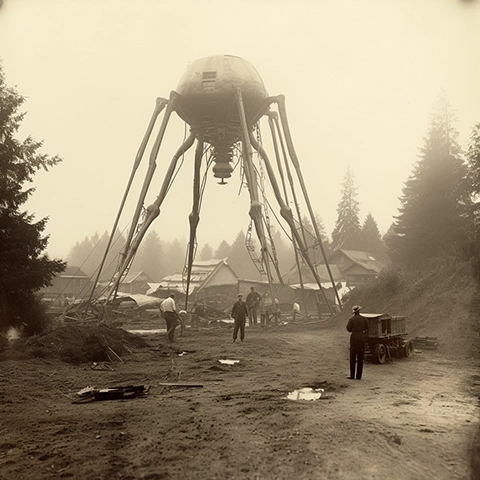In an era before flying saucers and alien conspiracies became household topics, an audacious group of pranksters devised a spectacle that convinced many Americans that Martians were descending upon Earth.
It was a brisk autumn evening in the quiet town of Oakland, California when the first “sightings” of extraterrestrial activity began. On November 17, 1901, news of an impending Martian invasion was all the rage in the newspapers. The stage had been set, quite literally, by a group of imaginative individuals led by Charles B. Ford, a writer, and journalist known for his love of science fiction and his passion for theater.
Ford, along with his friends and co-conspirators, rented a vacant lot near Telegraph Avenue in Oakland. There, they erected a colossal, 35-foot-tall “Martian” tripod, a fictional war machine inspired by H.G. Wells’ “The War of the Worlds.” The contraption was constructed with great attention to detail, complete with mechanical legs and an eerie, otherworldly design. Inside the tripod, Ford and his cohorts would operate various mechanisms to create mysterious sounds and dazzling lights.
As the sun set over the sleepy town, the Martian tripod came to life, emitting smoke and sparks, while the operators inside made eerie, dissonant sounds. The spectacle was not only visible but also audible to residents of Oakland. Panicked onlookers began to report the “Martian invasion” to local authorities and newspapers.
The news of the apparent invasion spread like wildfire. Newspapers across the country, always eager to provide sensational stories, jumped on the bandwagon. Headlines screamed of Martian war machines and their impending destruction of Earth. Speculation ran wild, and fear gripped the hearts of many. People began to flee the area, seeking refuge from the impending doom.
However, the true nature of the event was soon revealed. Charles B. Ford and his group had carefully orchestrated the hoax, and they eventually confessed to their elaborate prank, much to the chagrin of those who had fallen for it. The “invasion” had been a grand theatrical production, brilliantly executed to captivate the imagination of the public.
In the aftermath, the pranksters faced some criticism for causing panic, but the majority of Americans saw the funny side of the hoax. The Great UFO Hoax of 1901 was an ingenious blend of science fiction and performance art, a testament to the power of theater and imagination in an era before CGI and Hollywood blockbuster movies.
The legacy of the 1901 UFO hoax endures as a testament to human creativity and the boundless nature of human curiosity. It serves as a reminder that even in times of turmoil and uncertainty, the power of imagination and a touch of humor can unite people and lighten the weight of the world’s problems.
In the years that followed, more UFO sightings, both real and staged, would continue to capture the public’s fascination. However, the Great UFO Hoax of 1901 remains a unique and captivating chapter in the history of American mischief and the enduring fascination with life beyond our planet.

